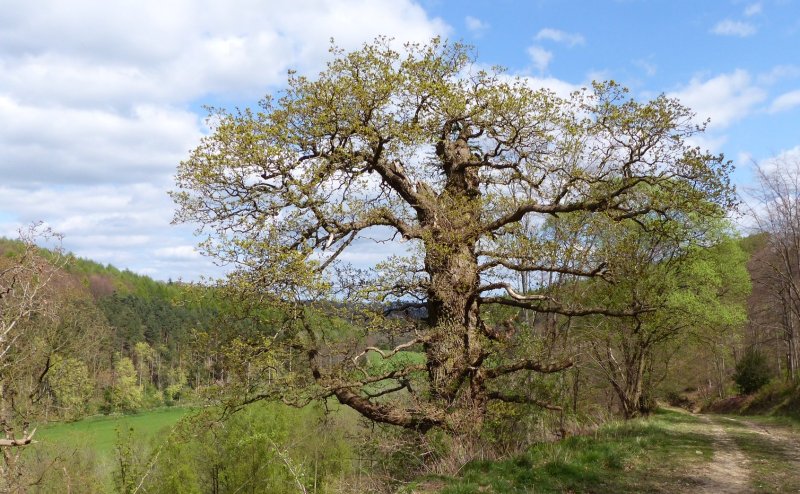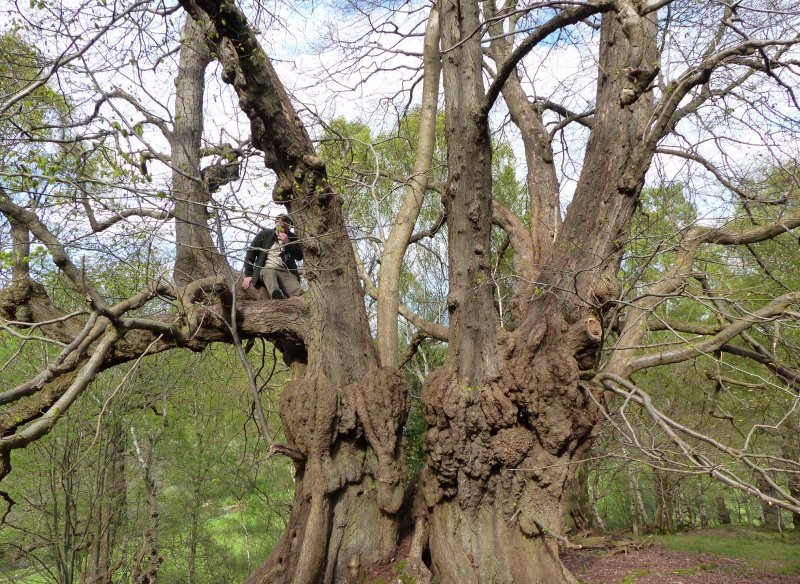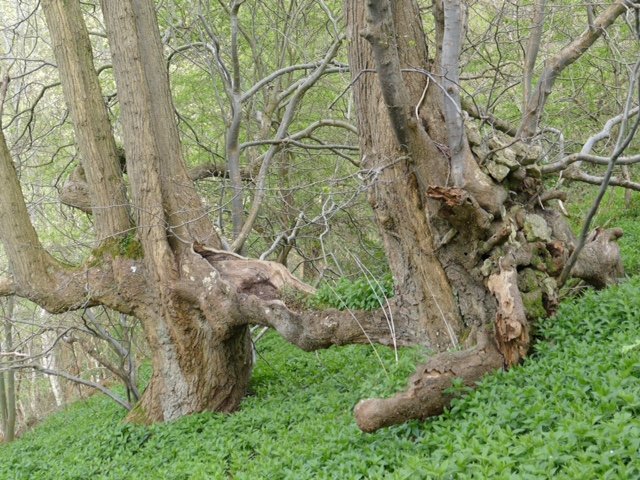
Back to the Home page
Species lists below

On a sunny but cool afternoon 15 of us gathered at the entrance to Waterloo Plantation, an area of woodland belonging to the Duncombe Park estate but managed by the Forestry Commission. Lead by retired Forestry Commision Wildlife Ranger, Brian Walker, we drove along forest tracks to the lower parts of the wood.
In the lower reaches of this plantation woodland are to be found numerous ancient Oak trees (Quercus robur, Quercus pedunculata and hybrids).
After parking the cars we ambled from tree to tree admiring their stature which varied considerably due to varying degrees of decay. Some still had fairly healthy crowns while others were reduced to just a rotting trunk. All had holes or splits, one to the point where the heart wood had decayed completely and a 6ft tall person could stand inside. On some parts of the decaying trunks and at varying heights seedlings had established themselves and so bilberry and young conifers could be seen sprouting. These trees had survived being felled over the centuries as being in estate parkland the lands primary purpose was for hunting. Believed to be 400 to 500 years old they had started to become smothered by planted conifers such as Western Red Cedar (Thuja plicata) and Western Hemlock (Tsuga heterophylla) but in more recent years the value of these ancient trees had become recognised and so the encroaching plantation trees had been felled and the area designated as SSSI. Brian explained trees of this age often harbour specialised and rare insects and fungi that need the decaying wood in which to thrive.

Returning to the cars and then driving on a mile further we next visited Castle Hill. Here again stood ancient Oaks but also Small-leaved Limes (Tilia cordata), the latter potentially much older than the Oaks due to their habit of readily layering, branches becoming new trunks and creating some interesting shapes.

Having regrouped back at our starting point we shared some delicious cake before thanking our leader and heading home.
Buzzard
Willow Warbler
Goldcrest
Chaffinch
Chiffchaff
Blue Tit
Swallow
Wren
Blackcap
Blackbird
Bullfinch
Robin
Goldfinch
Coal Tit
Jackdaw
Nuthatch
Curlew
Carrion Crow
Wood Pigeon
Great Tit
Thanks to Pauline for the plant list.
| Latin name | Common name |
|---|---|
| Ajuga reptans | Bugle |
| Alchemilla xanthochlora | Intermediate Lady's-mantle |
| Alliaria petiolata | Garlic Mustard |
| Alopecurus pratensis | Meadow Foxtail |
| Angelica sylvestris | Wild Angelica |
| Arctium agg. | Lesser Burdock |
| Arum maculatum | Lords-and-Ladies |
| Bellis perennis | Daisy |
| Blechnum spicant | Hard-fern |
| Brachypodium sylvaticum | False-brome |
| Carex flacca | Glaucous Sedge |
| Chamerion angustifolium | Rosebay Willowherb |
| Chrysosplenium oppositifolium | Opposite-leaved Golden-saxifrage |
| Cirsium arvense | Creeping Thistle |
| Cirsium palustre | Marsh Thistle |
| Corylus avellana | Hazel |
| Crataegus monogyna | Hawthorn |
| Cruciata laevipes | Crosswort |
| Deschampsia caespitosa subsp caespitosa | Tufted Hair-grass |
| Digitalis purpurea | Foxglove |
| Dryopteris dilatata | Broad Buckler-fern |
| Dryopteris filix-mas | Male-fern |
| Equisetum arvense | Field Horsetail |
| Fagus sylvatica | Beech |
| Fragaria vesca | Wild Strawberry |
| Geranium robertianum | Herb-Robert |
| Geum urbanum | Wood Avens |
| Glechoma hederaceae | Ground-ivy |
| Hedera helix | Ivy |
| Heracleum sphondylium | Hogweed |
| Hyacinthoides non-scripta | Bluebell |
| Juncus effusus | Soft-rush |
| Lathraea squamaria | Toothwort |
| Lonicera periclymenum | Honeysuckle |
| Mercurialis perennis | Dog's Mercury |
| Myosotis sylvatica | Wood Forget-me-not |
| Oxalis acetosella | Wood-sorrel |
| Plantago lanceolata | Ribwort Plantain |
| Plantago major | Greater Plantain |
| Potentilla anserina | Silverweed |
| Potentilla reptans | Creeping Cinquefoil |
| Potentilla sterilis | Barren Strawberry |
| Primula vulgaris | Primrose |
| Prunella vulgaris | Selfheal |
| Prunus spinosa | Blackthorn |
| Pteridium aquilinum | Bracken |
| Rubus fruticosus agg. | Bramble |
| Rumex acetosa | Common Sorrel |
| Scrophularia nodosa | Common Figwort |
| Senecio jacobea | Common Ragwort |
| Stachys sylvatica | Hedge Woundwort |
| Taraxacum officinale agg. | Dandelion |
| Teucrium scorodonia | Wood Sage |
| Tussilago farfara | Colt's-foot |
| Urtica dioica | Common Nettle |
| Vaccinium myrtillus | Bilberry |
| Veronica arvensis | Wall Speedwell |
| Veronica chamaedrys | Germander Speedwell |
| Viola riviniana | Common Dog-violet |
Peacock
Orange Tip
Small White
Notes by Terry Crawford
The woodlands are fairly acidic, but probably contain several species of terrestrial molluscs, especially in damp flushes. More problematic were the extremely dry conditions. The following slugs and snails were recorded.
|
Arion subfuscus Cepaea hortensis Deroceras reticulatum Lehmannia marginata Trochulus striolatus |
Dusky Slug White-lipped Snail Netted Field Slug Tree Slug Strawberry Snail |
Most enthusiasts of terrestrial molluscs use scientific names. Vernacular names are difficult as there is no standard list, and confusion can occur. For slugs I have used the preferred vernacular in Rowson, B. et al. (2014) Slugs of Britain and Ireland. AIDGAP Key, FSC Publications/National Museum of Wales. For snails I have taken vernaculars from Kerney, M.J. (1999) Atlas of the Land and Freshwater Molluscs of Britain and Ireland. Harley Books. Here are some comments.
Arion subfuscus was the most common species. This moderately sized slug occurs in a wide range of habitats, is usually some shade of brown, and if the mantle (just behind the head) is gently stroked with a piece of tissue it will turn bright orange-brown. Cepaea hortensis is one of the familiar humbug-like species (the other being Cepaea nemoralis with a brown lip). The shell colour can range from yellow, through pink, to brown, and may show none or up to five dark bands which may be fused to varying degrees. I saw three of these, all yellow, one with no bands, one with five separate bands, and one with fused bands. Deroceras reticulatum is ubiquitous, the small mottled brownish/creamy pest slug of gardens, characterized by production of milky mucous when disturbed. Lehmannia marginata is less common. It is a woodland species that will climb trees in wet conditions. When handled it usually produces copious quantities of very watery mucous. I saw only one, which did not react with mucous production and remained sticky; this is indicative of the extremely dry conditions. Trochulus striolatus is a very common snail occurring in a wide variety of habitats. It is rather flattened, about 10 to 15 mm diameter when adult, with quite coarse striations on the shell and a slight keel around the “shoulder” of the shell. It can be a pest in gardens. It is strangely absent from a large area of the English Midlands.
| © Ryedale Natural History Society 2017, Photos © Keith Gittens, Pauline Popely 2017 |